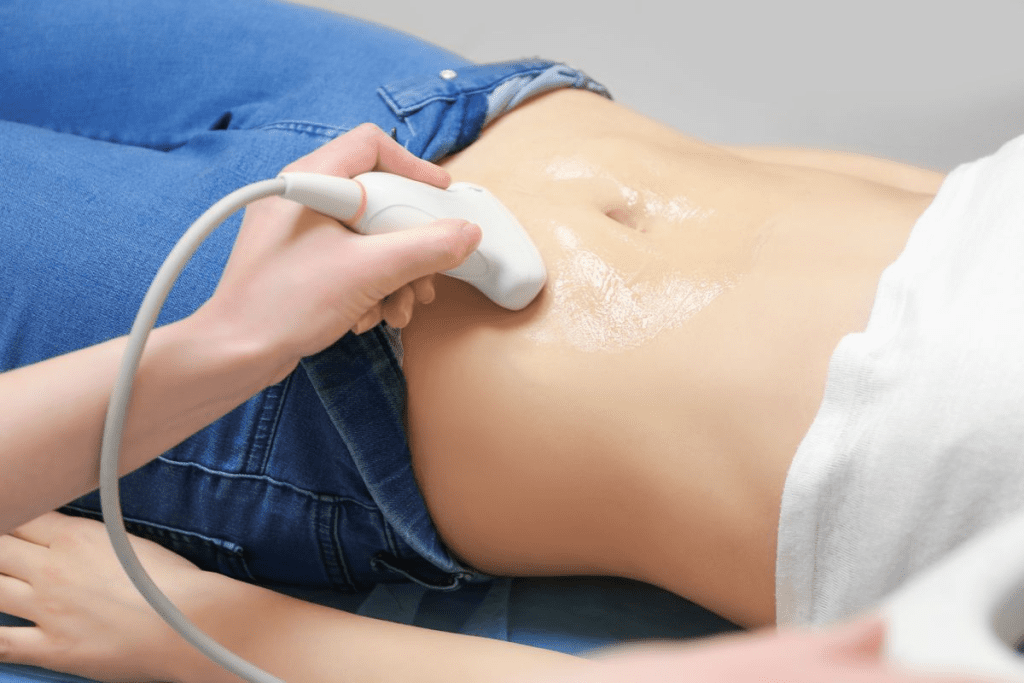Last Updated on November 25, 2025 by
Getting ready for a pelvic ultrasound might seem scary, but knowing what to do can help. Many wonder if they need to shave before it.
Don’t worry, shaving is not needed for a bladder ultrasound. Doctors say that pubic hair doesn’t mess up the vaginal ultrasound or usg pelvis sonography images. We care about your comfort and making sure the ultrasound is clear.
Many people wonder if they should shave before a bladder ultrasound. But the truth is simple: no, shaving is not required. This test, known as pelvic ultrasonography, helps doctors check the bladder and nearby organs.

Body hair doesn’t mess with ultrasound images. Hair doesn’t stop sound waves from going through the skin. This lets doctors see the bladder and other pelvic areas clearly during the test.
Doctors say that ultrasound images aren’t affected by body hair. This is because ultrasound uses sound waves, not light, to make pictures.
Big medical guidelines say you don’t need to shave before a bladder ultrasound. They tell patients they don’t have to do anything special to prepare for the test.
“Patients should be reassured that their preparation for a pelvic ultrasound does not include shaving or removing body hair.”
Liv Hospital Guidelines
This makes the procedure easier and less stressful for patients. It means they don’t have to worry about shaving or getting ready in a certain way.
A bladder ultrasound is a test that shows the bladder and nearby areas. It’s a safe way to check the bladder’s health and find any problems.

Bladder ultrasounds use sound waves to make images of the bladder. This method, called ultrasonography, lets doctors see the bladder’s size, shape, and health. A gel is applied to the belly to help sound waves move, and a transducer captures the images.
“Ultrasound technology has revolutionized diagnostic medicine by providing a safe, non-invasive means to visualize internal organs.” The clear images help doctors make accurate diagnoses and plan treatments.
People get a bladder ultrasound for symptoms like leaking urine, needing to pee a lot, or belly pain. It’s also used to check the bladder after surgery or to find the cause of frequent infections.
Knowing how bladder ultrasounds work and why they’re done helps patients get ready. It also shows how important this test is for getting accurate health information.
Preparing for a pelvic ultrasound is essential. You need to arrive with a full bladder. This is key to getting clear images during a pelvic sonogram.
A full bladder is vital for a pelvic ultrasound. It lets sound waves pass through to see the pelvic organs well. With a full bladder, the intestines move out of the way, making the organs easier to see.
During a pelvic ultrasound, sound waves are sent out by the probe. These waves go better through fluid, like urine in a full bladder. This is why a full bladder is so important for the procedure.

To fill your bladder right, drink water about an hour before your pelvic ultrasound. You want to be comfortably full, not too tight. For a pelvic ultrasound transvag, your doctor will give you special instructions.
By following these tips, you can help make sure your pelvic ultrasound or pelvic sonogram goes well. This helps doctors make accurate diagnoses and plan the best treatments.
To have a successful bladder ultrasound, follow this guide. It covers what to do before and during your visit to the imaging center.
Before your ultrasound, keep drinking water as usual. You don’t need to change your water intake much. But staying hydrated is key for the test.
Drink 1 liter (32 ounces) of water about an hour before your appointment. This fills your bladder well for the ultrasound. Don’t empty your bladder until the test is over.
When you arrive, you’ll go to the ultrasound room. Our technologists will explain everything and answer your questions. The steps are the same for a pelvic ultrasound vs vaginal ultrasound and a standard bladder ultrasound.
Knowing what an internal ultrasound shows can prepare you mentally. An internal ultrasound gives clear images of your organs. It helps find many health issues.
By following these steps, you’ll be ready for your bladder ultrasound. This ensures a smooth and effective procedure.
The ultrasound gel application is key in the pelvic sonography process. We use a clear, water-based gel. It helps sound waves pass through the skin, giving us clear images of the bladder and nearby areas.
The gel acts as a lubricant, removing air pockets between the skin and the ultrasound transducer. This is vital because air can block sound waves, causing blurry images. A medical expert says, “Using ultrasound gel is a common practice in sonography. It improves the accuracy of the procedure.”
Our technologists are skilled in applying the gel smoothly, even with body hair. The gel is easy to apply and remove, making it comfortable for patients.
We use hypoallergenic ultrasound gel for patients with sensitive skin. This gel is made to avoid allergic reactions or skin irritation. It ensures a safe and comfortable experience for everyone.
With top-notch ultrasound gel and skilled technologists, we make the pelvic sonography procedure effective and comfortable for our patients.
Pelvic ultrasounds are key tools for doctors. They come in various types, each with its own purpose. The right choice depends on why the ultrasound is needed and the patient’s health.
A transabdominal bladder ultrasound is a simple test. The probe is placed on the belly to see the pelvic organs. It’s often used to check the bladder and nearby areas. This test is easy and only needs a full bladder. It’s vital for bladder-related issues.
A transvaginal ultrasound, or vaginal ultrasound, is different. The probe goes into the vagina for clearer images of the uterus and ovaries. This method gives a detailed look at these organs. It’s mainly for women and often paired with USG pelvis sonography.
Choosing between transabdominal and transvaginal ultrasounds depends on the doctor’s needs. For example:
Knowing the differences helps patients get ready for their ultrasound.
International standards for ultrasound preparation are key to top-notch diagnostic images. These standards come from deep medical research. They aim to improve the quality of pelvic ultrasonography.
Medical studies prove that good preparation is vital for ultrasound success. They show a full bladder is essential for a uterus ultrasound and other pelvic scans. A full bladder makes pelvic structures clearer by acting as a sound window.
“Adequate preparation is essential for obtaining high-quality ultrasound images,” as many medical journals say. This is very true for pelvic ultrasound vs transvaginal ultrasound. The right choice depends on what the doctor needs to see.
Liv Hospital sticks to strict ultrasound preparation rules. By following global guidelines, Liv Hospital makes sure patients get the best care. Their strict adherence shows their commitment to accurate imaging.
Liv Hospital puts patient comfort and image quality first in ultrasound prep. By sticking to international standards, the hospital makes sure patients are comfortable. At the same time, they get top-notch images.
We know patient comfort is important. Our protocols aim to reduce any discomfort. They also make sure the ultrasound images are very useful.
We’ve learned that shaving isn’t needed for a bladder ultrasound. The main thing is to have a full bladder. This helps sound waves move well, giving clear images.
To get ready for a pelvic ultrasound, follow your healthcare provider’s advice. You’ll need to drink water and arrive with a full bladder. Knowing what to expect can make you feel less nervous.
A pelvic sonogram is another name for a pelvic ultrasound. It’s a safe way to check the pelvic area. By preparing well and knowing what’s happening, you’ll have a good experience.
No, shaving is not required for a bladder ultrasound. Body hair does not affect the quality of the ultrasound images.
A bladder ultrasound checks the bladder and nearby areas. It can spot issues like urinary problems, stones, and tumors.
To get ready for a pelvic ultrasound, fill your bladder. Drink water an hour before to fill it well.
The right ultrasound depends on your condition. You might need a transabdominal or transvaginal ultrasound. Your doctor will choose the best one for you.
Yes, the gel is safe and gentle. It helps sound waves and doesn’t react with body hair.
Top hospitals like Liv Hospital follow global ultrasound prep guidelines. They focus on comfort and quality images.
Transabdominal ultrasounds go through the belly. Transvaginal ultrasounds go through the vagina. Your doctor picks the best one for you.
A full bladder makes images clearer by helping sound waves travel better. It also moves the intestines out of the way for a better view.
Tran, L. N. (2024). Urinary Incontinence. In StatPearls [Internet]. StatPearls Publishing. https://www.ncbi.nlm.nih.gov/books/NBK559095/
Subscribe to our e-newsletter to stay informed about the latest innovations in the world of health and exclusive offers!